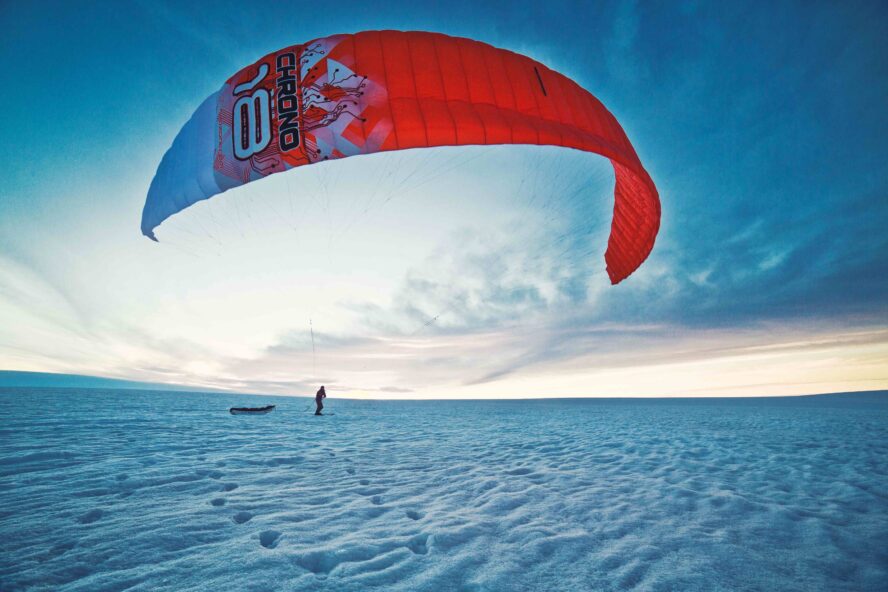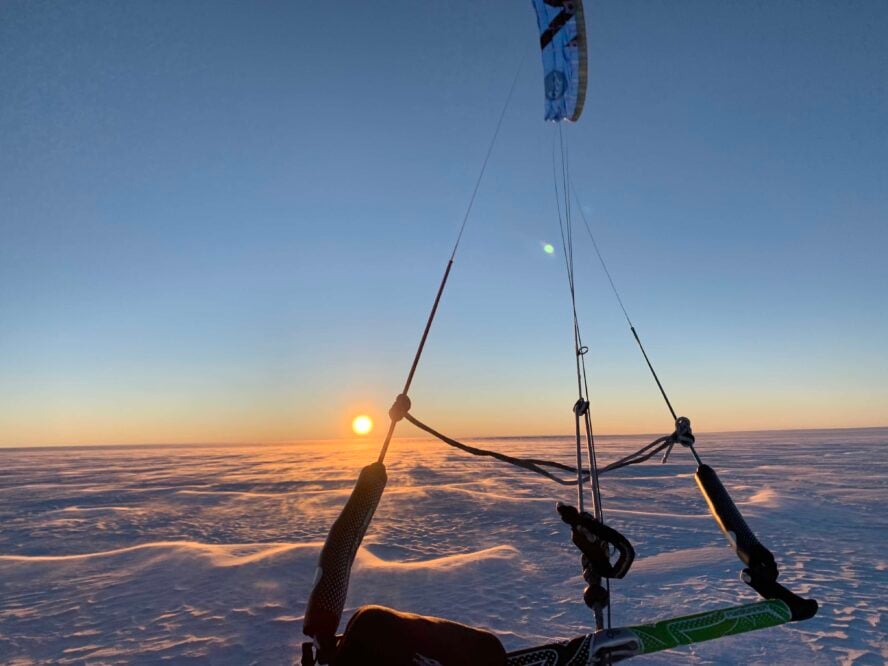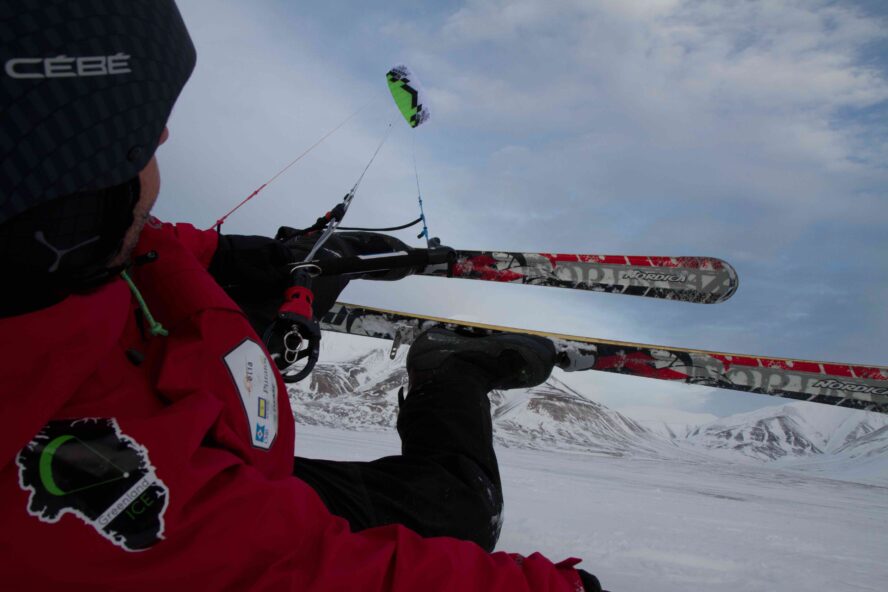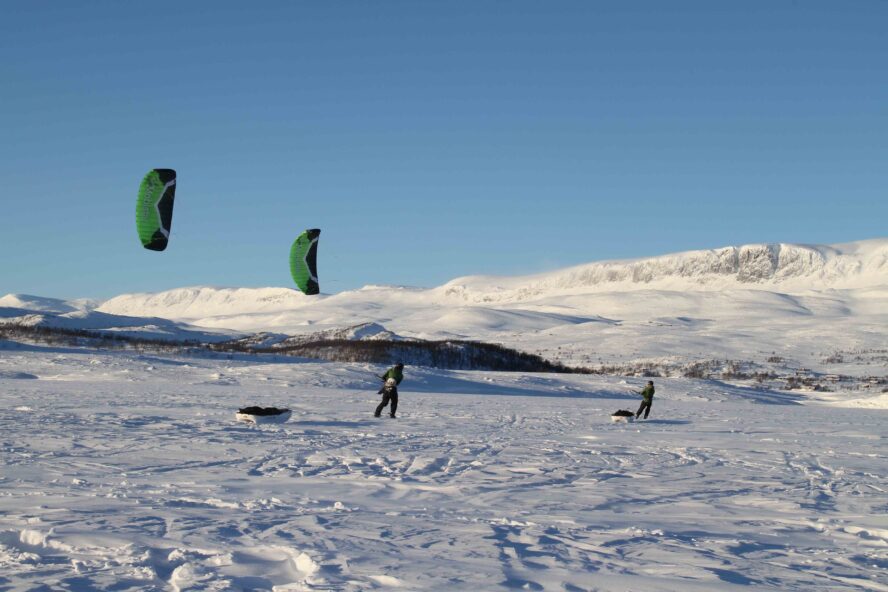Snowkiting will have you rocketing over snow using one of the most powerful forces of nature — the wind. You won’t quite be flying, but it’s a close second. Similar to the basic principles of kitesurfing, snowkiters developed this winter sport to ski and snowboard over frozen landscapes by steering kites. The heart of snowkiting is discovery, where vast expanses of snow are turned into adrenaline-fueled playgrounds. If you’ve ever wondered what the exciting-looking sport is all about, look no further. Here’s the snowkiting basics that you need to know to get started.

I’ve been using snowkiting techniques to explore all over the world, from polar regions like Greenland and Siberia, to other snow-filled destinations like Canada, the Alps, and Alaska. I’m the author of Snowkiting, Freedom of Flow, and I work with adventure seekers to help them understand the basic physics of the wind, safety procedures, kite manipulation, on-the-go repairs and how to pick out gear.
It’s my opinion to start with a coach for snowkiting lessons. Coaches help those new to the sport make smart decisions in the moment. Losing control of the kite due to inexperience can be dangerous. Training to learn how to maintain the correct stance and steering techniques are key to ease and fun on the snow. With a little instruction, you’ll be well on your way to becoming a self-sufficient snowkiter.
Snowkiting beginners will benefit from technique instead of strength
In terms of fitness requirements, there aren’t many limitations for snowkiting beginners. Snowkiting is a sport that relies on technique, rather than strength. Solid intermediate to advanced skiing or snowboarding skills are a must. Knowing how to ski or ride allows for the focus to be on manipulating the kite. Muscle memory takes care of the rest. Experience sailing can also be helpful to understand wind movement. Kitesurfers and skiers might have an advantage. Almost anyone can become a snowkiter with the right instruction and determination.

Snowkites use the power of the wind to navigate open spaces
Snowkiting attempts will be fruitless without steady wind to pull your kite. The wind is an invaluable ally but can be a powerful adversary as a snowkiting beginner. The goal is to use the power to your advantage. Safety releases are also important and available if anything gets out of hand. Due to the unpredictability of the wind, always practice in open spaces, avoid anything the kite could get stuck on. It’s also important to monitor wind conditions constantly, especially for any unwanted developments. Before heading out, make sure to have an understanding of turbulence and obstructions. Long distance expedition tours are plotted out according to the direction of the dominant winds. Beginners should start snowkiting in five to 10 knots of wind and no stronger than 21 knots (30-38 km/h).
Think of wind windows as 180-degree domes closing around the snowkiter. Their orientation aligns with the direction of the wind and the position of the kite determines the pull. Steering the kite in the wind direction, at about 60 degrees, gives you maximum power. Turning 90 degrees from the general wind direction and steering your kite in 60 degrees gives you minimum power.

Snowkiting in Norway might be a popular but the options are endless
Snowkiting locations are found around the world. Many of the best are in the Northern Hemisphere, and snowkiting in Norway remains a must-visit for expeditions. My personal favorite snowkiting destination is Greenland. The snow is soft and dry, and without deeper powder to mask obstacles. Plus, you can kite ski or kite snowboarding under either Northern Lights or midnight sun when timed right. Not everyone can head out to Greenland for a week or month-long expedition. Wherever you can find snow and wind, you can pretty much count on snowkiting being an option. Newcomers can check out snowkite lessons in New York and snowkite lessons in Salt Lake City, just to name a couple spots.
Snowkiting opens up a range of contemporary winter sports
Confident snowkiters might be asking, what’s next? If you’re craving some competition, try out course racing. Lone wolves looking for an adrenaline rush can push themselves with speed trials and trick snowkiting. Snowkites are ideal for the mountains and skiing uphill without any of the exhausting legwork. Backcountry snowkiting opens up a wealth of terrain in order to quickly bag peaks that seemed inaccessible. Expeditions are another adventure that will challenge your abilities in wild landscapes. I’ve led expeditions all over the world, including setting records in Antarctica. For confident snowkiters, I lead travelers ready to head to Siberia on a once-in-a-lifetime polar expedition on Lake Baikal — one of the deepest and oldest lakes on Earth.
Expeditions also require extensive knowledge of polar camping, wilderness skills and fitness preparation for long-distance trekking. If you’ve spent a winter night in a tent, learning how to winter camp is an essential skill needed for bigger trips. It’s also an unforgettable journey that might change your perspective of what’s possible.
Why it Pays to Take Snowkiting Lessons
Snowkiting harnesses one of the most powerful forces of nature to reach untouched landscapes. Why not first, capture winds in thrilling and accessible playgrounds? Before kite skiing or kite snowboarding for the first time, you need to know the mechanics of the gear and be aware of safety precautions. It also helps to keep your cool and go with the flow — and know how to stop when control is lost. A good course will take any guesswork and unnecessary danger out of the equation. Snowkiting lessons offer additional instruction about technique to improve in the moment. Guides can even recommend the best gear for your price point.

Level 1: Getting acquainted with the trainer kite
On the first day of snowkiting lessons, we start anyone new to the equipment on a training kite. A trainer kite isn’t connected to the snowkiter by a typical harness. Instead, a safety leash is attached to the wrist. This setup helps teach snowkiting beginners how to read the wind and get used to the strength of the kite. Once you let go of the bar, the wrist leash disturbs the profile of the kite to deflate to the ground. Much like with kiteboarding or kitesurfing on water, the first skills to develop are launching and landing. Launching is maneuvering the kit into the air. You want the pull of the wind to be manageable and the kite in the proper position. Landing is the term for stalling the kite when you want to stop, a necessary step to maintain control and take care of the gear. After mastering the basics of working the kite, you’ll experience the wind window and attempt to steer the kite. Expect to get pulled around a bit while getting comfortable with the techniques.
Level 2: Upgrading to a full-sized snowkite harness
Once you feel confident gliding with your trainer kite, it’s time to progress to a full-size, traction kite. You’ll take what you learned on the training kit to launch and land a kite with a body harness. This progression doesn’t only depend on your skills. You are at mercy of the wind. Before you launch the kite, you’ll go over all necessary safety procedures. Knowledge of kite construction and how it operates allows you to use its full ability in any wind conditions. Plus, it helps you work out any hiccups like fickle wind knots. You’ll also know what to do if the kite turns over or how to loosen the hold if it’s too stiff. Being confident in the theory behind powering and depowering the kite is necessary to upgrade to skis or a snowboard.
Level 3: Progression with the snowkite
This snowkiting session is all about taking your first flight. Riding is the fun part. It will put that practice to the test. The previous sessions set up snowkiting beginners to navigate the full equipment with confidence. Level 3 deals with all of the techniques needed for navigation when riding. The course will focus on practicing movement in different directions, as well as riding upwind and downwind. Once you’re riding, you’ll learn to control the speed and power of the kite. It’s getting comfortable combining the positioning of the kite, body angle to the wind and angle of your skis or snowboard for smooth sailing. Your snowkiting guide will be able to offer tips and insights to improving your technique, grip and edging. The end result is snowkiting independently on the snow.

How to Get Started for Snowkiting Beginners
Snowkiting pulls skiers and riders uphill on mountains, above treeline, ice caps and any snow-covered expanse. Beginners will want to steer clear of icy surfaces because little to no friction requires more complex kite and ski manipulation. Even the thinnest layer of snow makes a difference. You can’t snowkite, however, without snow and strong winds. Snow often means frigid temperatures. Don’t let the cold deter you, though. Dressing in the right gear will keep you comfortable in all sorts of weather. Above all, planning is key when heading out for your first snowkiting tours. I’ve compiled some of the most common topics I address for people starting out.
How does the kite mechanism work?
The main goal is for the kite to remain stretched. Making sure all your lines are in position is crucial. The kite wouldn’t hold the right profile if the bridles, the set of ropes connected to the kite, failed to do their job. The bridles come together in the back lines, which are used for steering. In between the bridles are the front lines that pull the hardest. Take your time to learn exactly where they should be even before you put your skis on.The front lines run through the bar, connecting to the safety system attached to the harness around your waist. If you release the safety, the kite will lose its profile and stop pulling. You’ll still be attached to the leash, preventing your kite from taking off.

Beginners can use kitesurfing and skiing gear when starting out
Recreational kitesurfers can use their kit to test out snowkiting. Waterbound kits are heavier and can be damaged in the cold, especially if it lands on ice or snow. Be aware that the inflated part of your kite could delaminate and the glue might give out. Snowkites are more efficient for long-distance travel. Same goes for your skis. Your downhill skis and snowboard will work well. Since you use the edges in their entirety, you don’t want the skis to be too long. Snowboards and splitboards work, but opt for skis if you plan to snowkite longer distances. Also, don’t free-heel for a long amount of time. Your regular ski touring boots and bindings will protect your ankles better, making the entire experience more enjoyable.
When picking out the right harness, make sure it goes under your hips. The harness takes the brunt of the wind power. If it’s too small, it can create discomfort. Some people feel more comfortable with leg loops, allowing the harness to stay low even when the kite rises. For expeditions, I recommend a seat harness to support your lower back and take a break over hours of traversing. I don’t recommend using a climbing harness because it can cause serious back issues.
Snowkite equipment doesn’t need to be fancy, just comfortable
Snowkiting doesn’t require complex gear, but it helps knowing where to invest when starting out. The list of equipment is short and sweet. Skiers and snowboarders will be able to use their own equipment. You’ll need skis and standard touring boots or a snowboard or splitboard with boots. Additional equipment needed will be a kite with trusty bridles and lines, as well as a comfortable harness and a safety leash. Single-foil kites used for snowkiting are easier to roll and don’t allow snow in the crevices. No matter what type of kite you use, make sure you know that your safety systems will work in lower temperatures. Beginner kites start around $100 and the price goes up as you progress into more advanced disciplines. If you’re looking for an all purpose kite, go with the 12-meter (40-foot) kite. It’s perfect for lower winds and it isn’t as heavy as an 18-meter (60-foot) kite. Before heading out, consider how the size of your kite mixes with the weather conditions.

Navigating your snow kiteboard is easier than it looks
You might feel like you’ll need an extra hand considering you’ll simultaneously ski, lift the kite and steer in a vast, open space. Thankfully, there are a lot of GPS equipment and compasses to work for you. The wind has a significant role in dictating where you’ll go. Knowing the direction in which the wind blows beforehand can be helpful. Even if you go off-course at some point, you can easily change direction. In long distance travel, you should opt for the easiest and fastest course.
Can you learn how to snowkite on your own?
Snowkiting is a challenging and technical winter sport. Training on your own does limit you to trial by error, which could be a risk to your safety. The kite can easily lift a person off the ground, if they’re not careful and prepared. Similar to skiing or snowboarding, learning techniques from a pro also allows for quicker progression. Instructors demonstrate how to hold a kite and are able to point out how to improve your stance, grip and maneuvering. Snowkiting lessons will also teach beginners how to handle gear, such as packing kites correctly and control the kite against strong winds. Most importantly, guides are there to keep everyone safe. When taking on snowkiting, research on how the gear works.

Safety procedures need to be fresh on your mind before heading out, including how to control the pull of the kite and how to work with the wind. It’s advised to bring a buddy to assist. Find a location with a layer of smooth snow and plenty of open space. The learning curve is steep and it will take a while to master the basics. With enough patience and practice, you can become a snowkiter.
If you want to hear Dixie discuss the basics of snowkiting in more depth, watch his webinar with 57hours on Snowkiting for Beginners: Everything You Need to Know to Start Snowkiting over on our YouTube channel:



